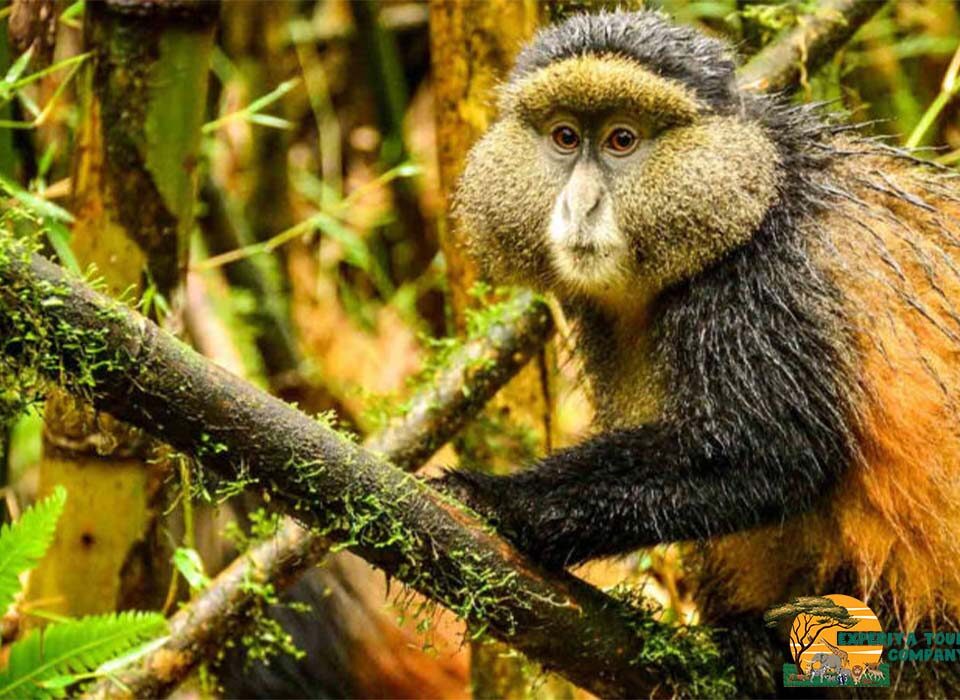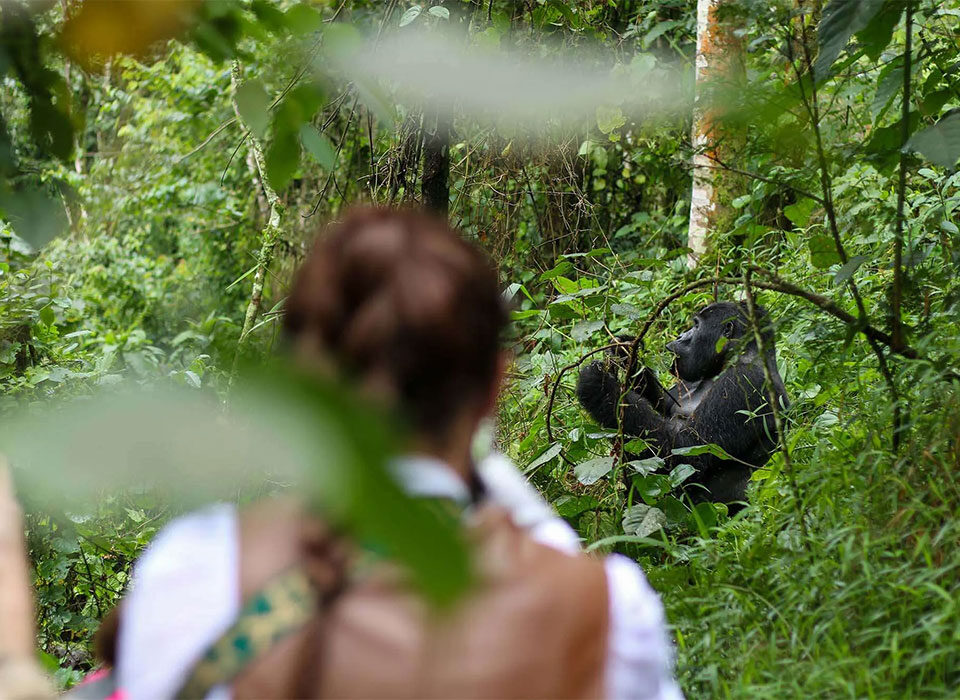
What Wildlife Lives Alongside Chimpanzees – Discover Kibale’s Rich Biodiversity
October 25, 2025
Can I Go White-Water Rafting on the Nile in Jinja – Uganda’s Ultimate Adventure
October 25, 2025How Many Chimpanzees Are in Uganda – Population, Habitats & Conservation

How Many Chimpanzees Are in Uganda?
Uganda, the “Pearl of Africa,” is one of the most biodiverse countries on the continent, home to lush forests, rolling savannas, and misty mountains that harbor some of the world’s most remarkable wildlife. Among its treasures are our closest living relatives—the chimpanzees. These intelligent, social, and charismatic primates are one of Uganda’s greatest natural assets, drawing travelers and researchers from all over the world. But just how many chimpanzees live in Uganda today?
To answer that, we need to look not only at numbers but also at where these chimpanzees live, how they are counted, and what is being done to protect them. Uganda’s chimpanzee population is part of a delicate ecological balance, one that reflects both the success and the challenges of wildlife conservation in the modern era.
The Chimpanzee Population in Uganda
According to conservation research and the Uganda Wildlife Authority, Uganda is home to an estimated 5,000 to 6,000 chimpanzees, making it one of the largest and most stable populations of wild chimpanzees in East Africa. These chimpanzees belong to the eastern chimpanzee subspecies (Pan troglodytes schweinfurthii), the same type found in neighboring countries like Rwanda, Tanzania, and the Democratic Republic of Congo.
While chimpanzees once roamed vast tracts of African forest, habitat loss and human encroachment have restricted them to isolated patches. Uganda’s population remains significant thanks to its network of protected areas, which serve as sanctuaries for these great apes. The largest and most famous of these strongholds is Kibale Forest National Park, often called the “Primate Capital of the World.”
Kibale Forest National Park – The Heart of Uganda’s Chimpanzee Kingdom
If there is one place in Uganda where chimpanzees truly reign, it is Kibale Forest National Park. Located in western Uganda, this 795-square-kilometer rainforest shelters about 1,500 chimpanzees, the highest density of wild chimps in Africa.
Kibale’s environment—rich in fruiting trees, dense canopies, and abundant water—creates a perfect home for these primates. The park is also renowned for its chimpanzee habituation program, a unique experience allowing visitors to spend extended hours following semi-habituated chimp groups as they go about their daily routines.
Walking through the forest at dawn, you may hear the rising chorus of chimpanzee pant-hoots echoing across the canopy—a sound that sends a thrill through every visitor. Seeing a mother cradle her infant, or a dominant male drum on the buttress roots of a giant tree, connects you to a world that mirrors our own.
Kibale is also home to 12 other primate species, making it a living museum of evolution. But the chimpanzees are undoubtedly its crown jewel, representing one of the most successful examples of primate conservation in Africa.

Budongo Forest Reserve – Northern Uganda’s Chimpanzee Haven
To the north of Kibale lies Budongo Forest Reserve, part of the greater Murchison Falls Conservation Area. Covering roughly 825 square kilometers, Budongo is another vital chimpanzee habitat, home to an estimated 700 to 900 individuals.
Budongo is famous for its long-term chimpanzee research programs, particularly at the Budongo Conservation Field Station (BCFS), which has been operating since the 1990s. Scientists here have studied chimpanzee behavior, communication, and tool use, contributing greatly to our understanding of these complex animals.
Tourists visiting Budongo can enjoy chimpanzee tracking experiences from Kaniyo Pabidi Eco-Tourism Site, managed by the Jane Goodall Institute and the Uganda Wildlife Authority. The forest’s tall mahogany and ironwood trees provide a magnificent backdrop for sightings, and encounters often feel more intimate due to smaller tourist numbers compared to Kibale.
Kyambura Gorge – The “Valley of the Apes”
In the heart of Queen Elizabeth National Park, the dramatic Kyambura Gorge shelters another small but remarkable population of chimpanzees—around 30 to 50 individuals. This sunken tropical forest, sometimes called the “Valley of the Apes,” forms an isolated oasis surrounded by the vast savannas of the park.
Because of its unique topography, the Kyambura population has become somewhat genetically isolated from other chimp groups, raising conservation concerns. However, the gorge remains a magical place for visitors who can descend into its green depths to track chimpanzees, often while hearing hippos grunting in the nearby Kazinga Channel or spotting elephants on the rim above.
Kyambura Gorge offers one of the most surreal chimpanzee tracking settings in Africa—a mix of jungle mystery and dramatic geological beauty.
Semuliki National Park – A Congo-Like Wilderness
Farther west, along the border with the Democratic Republic of Congo, lies Semuliki National Park, a lowland rainforest rich in biodiversity. This park hosts a smaller chimpanzee population, estimated at around 250 individuals, but they are uniquely adapted to both forest and savanna environments.
Research has shown that Semuliki’s chimpanzees sometimes walk on the ground between forest patches, displaying behavior more commonly associated with savanna-dwelling chimps of western Uganda and eastern Congo. This adaptation highlights the species’ incredible flexibility and intelligence.
Other Chimpanzee Habitats in Uganda
Beyond these major parks, smaller chimpanzee communities are scattered across Uganda’s forest reserves and protected corridors. The Bugoma Forest Reserve, located between Hoima and Kagadi, is one such area, home to roughly 500 chimpanzees. Conservationists are currently fighting to protect Bugoma from deforestation and land conversion for agriculture, emphasizing its importance as a habitat link between Kibale and Murchison Falls ecosystems.
Other areas such as Toro-Semliki Wildlife Reserve, Kasyoha-Kitomi, Maramagambo Forest, and Kalinzu Forest Reserve also support smaller chimp populations ranging from 100 to 400 individuals each.
Among these, Kalinzu Forest, near Bushenyi in southwestern Uganda, has become a growing eco-tourism destination. With about 320 chimpanzees, of which a portion is habituated for tourism, Kalinzu offers a rewarding alternative for travelers seeking a quieter experience compared to Kibale.
The Challenges Facing Uganda’s Chimpanzees
While Uganda’s chimpanzee population remains relatively stable compared to other regions in Africa, threats persist. Habitat loss remains the greatest danger, driven by agriculture, logging, and human settlement. As forests shrink, chimpanzees are forced into smaller ranges, increasing the risk of human-wildlife conflict.
In some areas, chimpanzees raid crops such as bananas or sugarcane, leading to tensions with local communities. Poaching—though less common for meat—still occurs, and sometimes chimps are injured or killed in snares meant for other animals.
Disease transmission is another growing concern, especially as chimpanzees share 98% of their DNA with humans. Respiratory infections and viruses can spread rapidly within groups, especially when contact with people increases through tourism or encroachment.
To mitigate these risks, Uganda Wildlife Authority and partners such as the Jane Goodall Institute, Chimpanzee Trust, and various NGOs have implemented strong conservation measures. Education programs, community forest management, and eco-tourism initiatives have become vital tools for protecting chimpanzees while benefiting local people.
Conservation Success Through Tourism
Tourism plays a crucial role in chimpanzee conservation. Every trekking permit purchased directly contributes to park management, ranger salaries, and community projects that reduce reliance on forest exploitation.
At Kibale, for example, revenue-sharing programs fund schools, health centers, and small businesses around the park. This approach has turned local residents into protectors of the forest rather than adversaries.
Chimpanzee trekking itself is also conducted under strict guidelines. Group sizes are limited, observation times are regulated, and visitors must maintain a safe distance. These measures ensure the well-being of the animals while providing unforgettable encounters for travelers.
Uganda has proven that well-managed eco-tourism can serve as a bridge between conservation and development—a model now studied across Africa.
Uganda’s Chimpanzees in Global Context
Africa’s total wild chimpanzee population is estimated at around 170,000 to 300,000, scattered across 21 countries. Within this continental range, Uganda’s 5,000–6,000 individuals represent a significant stronghold—roughly 3% of all wild chimpanzees on Earth.
This makes Uganda one of the best places in the world to observe these primates in their natural habitat. Unlike many regions where chimpanzees are critically endangered or nearly extinct, Uganda has managed to maintain relatively stable numbers through consistent protection, scientific research, and sustainable tourism.
The Future of Chimpanzee Conservation in Uganda
The long-term survival of chimpanzees in Uganda depends on preserving the forest corridors that connect their habitats. Conservationists are now focusing on wildlife corridors, linking fragmented forests such as Kibale, Bugoma, and Budongo. These corridors allow genetic exchange between groups, ensuring healthy populations for generations to come.
Continued collaboration between government agencies, conservation organizations, and local communities will be key. Eco-tourism remains one of the most effective ways to generate awareness and funding for these efforts—offering travelers a chance not just to see chimpanzees, but to actively participate in their protection.
Experience Uganda’s Chimpanzees with Experiya Tour Company
If you’re dreaming of witnessing chimpanzees in the wild, there’s no better destination than Uganda—and no better partner than Experiya Tour Company. With deep expertise in East African primate safaris, Experiya specializes in crafting immersive journeys that connect you to Uganda’s natural wonders.
Their guided chimpanzee tracking tours take you through the heart of Kibale, Budongo, and Kyambura, led by knowledgeable local guides who bring the forest to life with stories, sounds, and insights. Experiya handles all logistics—from park permits and transport to comfortable eco-lodge stays—allowing you to focus fully on the magic of the experience.
Whether you’re a photographer, wildlife enthusiast, or first-time traveler, Experiya Tour Company ensures that your chimpanzee adventure is seamless, ethical, and unforgettable. By choosing Experiya, you’re not only exploring Uganda’s wild beauty—you’re helping to protect it for the future.



